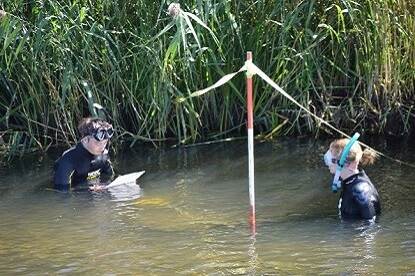Tollense field school - Part 2
Weblog
During the first two weeks of August 2022, students from Leiden University, University Rostock and University of Göttingen have joined the Tollense Field school to research an archaeological site in the Tollense Valley in northern Germany. The Cultural Heritage Agency participates in this field school to support capacity-building of a younger generation maritime archaeologists and to facilitate international knowledge exchange. In these series of blogs, students and partners tell about their experiences. Read more about this international fieldschool and the Tollense valley in the first weblog. Students Robin Jonker and Joelle Eversdijk tell about the third and fourth days of the field school.
On the third day of the field school at Tollense, it was quite warm, around 30 degrees Celsius. This day, the underwater research team was responsible for the underwater site, with a primary focus on the dugout. First, the dugout was cleared of all the waterplants so it could be documented accordingly. The first task of the day was to record new video footage of the dugout to process for photogrammetry. After the footage was taken, the dugout was measured by two divers using snorkels. These measurements were done as another method to record and document the dugout, as the visibility for photogrammetry was not optimal. Once the measurements were taken with two tape measures and written on the slate, the dugout could be drawn on dry land.

Meanwhile, other divers investigated the area around the dugout. An interesting finding of weaved reeds was found, possibly a basket or rats nest. Other findings in that area consisted of bone fragments and different species of nuts. Downstream in the riverbed, there were even more finds, mostly bone fragments. However, these were not in context. This means that the placements of these finds are not in their original place, as they could have been moved by the river current, weather or anthropological activities.

On the fourth day, the weather again was incredibly hot. We started using the dredge which is like an underwater vacuum cleaner. After only a few minutes, we noticed that the pump and engine started to smell funny, so we stopped dredging to investigate. It turned out that the engine was broken, so the dredging was put on hold until a new pump could be installed on the site. In the meantime, students investigated the riverbed, to see if there were any more finds on the surface, while other students kept clearing the dugout with their hands. At the end of the day, a new pump arrived, so the dredging could be continued.